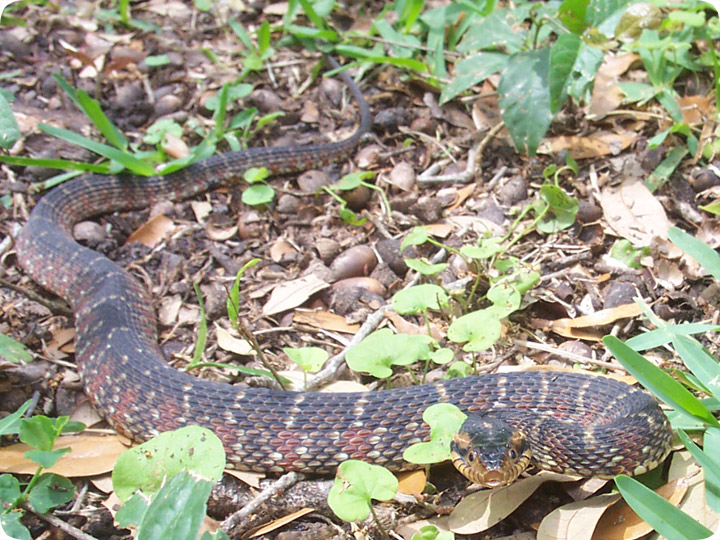-
info@aaanimalcontrol.com
Call us for help in your town
Humane Wildlife Education
Banded Water Snake

04.11.2004 - This is a Banded Water Snake (Nerodia fasciata). I have photographed it outside of its usual aquatic habitat. I was called to remove a snake from a home, and I was told that I'd be extracting a
Cottonmouth. I arrived at the house and was directed to the ornamental pond in the front landscaping, and sure enough, there sat the above snake, a species that I had
never seen before. It looked a bit darker in the rocks and water, and like most water snakes it had a thick body.
I captured it with my snake tongs, and it struck
several times as I transferred it to my snake bag, and I noticed that it had a white mouth. I thus concluded at the time that it was, in fact, a Cottonmouth. Oops,
I was wrong, and it was careless of me. At least I took safety precautions, and it's better to be wrong about a snake being venomous instead of harmless as opposed to
vice-versa, but still, I committed an error that many laypersons make about snakes, and which bothers me - assuming that a harmless snake is dangerous. I was aware that
Cottonmouths have differing and more distinct colors and patterns when small than the mostly black adults, and the body shape, behavior, and white mouth made me believe that it
was a Cottonmouth, but upon further research, I do see that it is a harmless Banded Water Snake. Aggressive, perhaps, but no fangs, no venom.
The Banded Water
Snake lives primarily in the Southeast United States, where it is fairly common. It's found in most bodies of water, and it doesn't live in dry areas. It grows to
about 4 feet as an adult. It feeds mostly on amphibians and fish. It gives birth in summer to live young. In these respects its similar to the Cottonmouth,
and many other water snakes, such as the common Northern Water Snake. If you see one, as usual with snakes, the best policy is to live and let live.
Do it yourself: Visit my How To Get Rid of Snakes page for tips and advice.
Get professional help: Visit my Nationwide Pro Directory of wildlife removal experts.
For more wildlife stories, click my Wildlife Blog
or click my below banner to hire a local trapper.
The banded water snake is considered a mid-size snake that averages about 24-48 inches in length. It features a heavy body with aquatic abilities. These snakes range in color from a shade of yellow to gray or brown. They have markings going across their back that are brown-black tones. These markings look like bands that do not go to the belly area. Older banded water snakes can also be solid brown-black in color.
Banded Water Snake Habitat
The habitat of the banded water snake includes the coastal plains that extend from North Carolina to Alabama. The banded water snake likes to be found near ponds and lakes as well as other water areas. They can swim and like to sunbathe on tree limbs as well as banks along the water. They can also be seen in shallow parts of the water looking for their next meal.
Banded Water Snake Diet
The diet of the banded water snake consists of fish and frogs. They also like crayfish, tadpoles, newts, and salamanders.
Reproduction
The banded water snake can give birth to live young between July and August of each year. They can birth up to twenty babies at one time however more than twenty is not unusual. When born, the baby banded water snake will be bright in color and approximately eight inches long with his/her pattern already in place. Baby banded water snakes will also strike to defend themselves if the need arises because they are born with that instinct.
Banded Water Snake Behavior
The behavior of this breed of snake is not one that you want to mess with. When they are driven to defend themselves, they will bite. This bite will release a foul and irritating odor that will hopefully run off what is confronting them. They have been known to be somewhat good as pets as long as they do not feel threatened. You can find them laying around day or night however the nighttime is when they are the most active.
Keeping the Banded Water Snake as a Pet
Many people decide to keep the banded water snake for various reasons. In many cases, they make good pets as long as they are handled right. They will even eat food from your hand but you may not want to try this until you are comfortable with your new pet. The water snake will escape if given the opportunity and you may end up finding them hiding within your home, making it difficult to get out of your home without releasing the foul smell and striking a part of your body.
If you need a banded water snake removed from your home, you will need to call a professional with experience in handling this type of snake to ensure the safety of the professional, you, your family, and your pets.




















